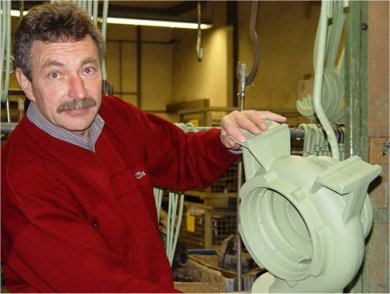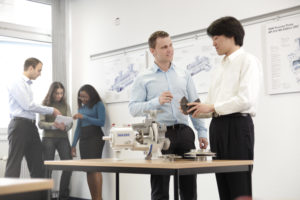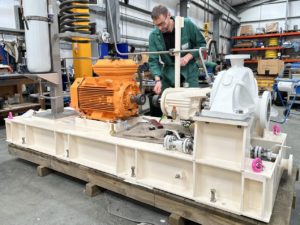Better Protection Thanks to Water-Soluble Varnish
Allweiler AG has increased the quality of their priming coats while at the same time reducing consumption of conventional solvents. By switching to water-soluble varnish,...

Johann Schmid, responsible for factory planning and engineering with the housing of an Allweiler centrifugal pump, freshly primed with water-soluble varnish (picture: Allweiler AG).
... the company will additionally reduce emissions of conventional solvents by eight tons per year. Due to increased layer thick-ness, new varnishes are more resistant and longer-lasting. Additional investments in modern procedures are about to be realized with a view to reducing consumption of organic sol-vents to about ten percent of the current amount by 2006.
Since November 2005, Allweiler AG has been using new products without organic solvents in two working steps. Parts are cleaned with modern, solvent-free cleaners instead of traditional cold cleaners. Water varnish that also does not require additives, is used in part primary coatings. Johann Schmid, who is responsible for the step-wise change at Allweiler, sums up the benefits of the new method as follows: “We achieve better priming coatings at a lower process cost. Moreover, we comply with the current EU Directive on Solvent Reduction”. According to plant manager Dr. Michael Matros, the advantages of the new production methods also include better working conditions and higher industrial safety standards.
The change is cost-neutral for Allweiler On the one hand, water-soluble varnishes are expensive. On the other hand, you now need lower temperatures for paint drying. Costs for exhaust air and fire protection equipment, which had been necessary so far, as organic-based solvents are air polluting and inflammable substances, are eliminated. The special safety and air purification systems used so far are no longer necessary.
In the course of further modernization, the company aims at reducing consumption of organic solvents to approx. ten percent of the current annual average consumption by 2006. Besides new varnishes and cleaners, new production methods and new machinery also play a role in achieving this goal. In the coming year, Allweiler will invest approx. 70,000 euros alone in such technologies. Measures are part of a comprehensive investment project with a view to ensuring a more efficient and even more environmentally-friendly production.
Source: ALLWEILER GmbH







